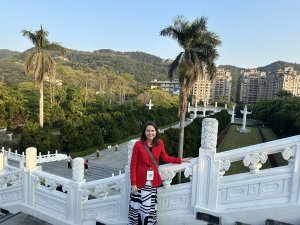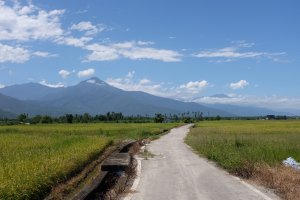Despite the ahistorical claims of those who misread “nationhood” into the millennia of history in present day Greater China, a “Chinese Nation” is a fairly recent concept. As a political ideal, its roots are found in the writings of late Qing dynasty anti-Manchu and anti-imperialist intellectuals and revolutionaries. As a “reality,” it is no older than the 20th century, and a persuasive argument has been made that national consciousness reached much of China only in the 1950’s.1 Nonetheless, the influence of “Chinese nationhood” on both China and the world should not be underestimated. The success of the Chinese Communist Party (CCP) in combining nationalism with anti-imperialism and anti-elitism is cited as an explanation for its civil war victory in 1949. 2 In the post-Maoism and post-global communism PRC, nationalism is cited by both Chinese leaders and outside observers as a primary pillar of regime security.
Indeed, as a cognitive political reality, Chinese nationhood seems to explain a lot. But how does it explain itself? What are its contents? What are the values and norms embodied in the Chinese national image? Is it merely an ultra-realist and humiliation-minded ego of national scale? These questions are fascinating in part because they are elusive. The nation is an “imagined political community.”3 As such, it is “by definition malleable, contextual, and capable of persistence and reconfiguration amidst socioeconomic and political change.”4 The content of nationhood, moreover, can be designed, re-engineered, and instilled by political elites. “Han nationalists” in the late Qing period designed a national narrative to legitimize the mobilization of Qing subjects against their government, inventing a Han nation in the process.
To exclude the Manchus from the Chinese nation, the vast ethnic, linguistic, and local cultural differences were subsumed under and erased by a Han identity… Zhang [Binglin] used historical narrative to endow the Han lineage with a subjectivity that homogenized the various dynasties into one Chinese Han lineage (Hanzu) that fought constantly and courageously against barbarians, the equally homogenous Other(s)… this imagination of the Chinese nation as a mammoth Han lineage descended from Huangdi drew upon the symbolic sources of social Darwinism, Enlightenment discourse on the nation, and indigenous lineage discourse.5
Thus early “Chinese nationalism” was explicitly ethnic in orientation (or “racist” in popular terminology). As the new Republic of China took on the challenge of governing the former Qing empire, however, Sun Yat-sen and his contemporaries rapidly turned away from ethnic nationalism and Wilsonian self-determination, instead embracing a doctrine of ethnic unification. 6
In a similar pattern, the CCP advocated ethnic self-determination for Tibetans, Xinjiang Uighurs, Mongols as a means of leveraging ethnic minority populations during its struggle against the KMT, but immediately crushed the concept upon founding the PRC.7 Whether Qing, Republican, or Communist, the governments of 20th century China have been unenthusiastic to release control of China’s massive and strategically valuable ethnic minority regions. As a result, the kind of nationalism endorsed by China’s leaders has, time and time again, been determined by the political consideration of where the nation’s borders should be drawn.
Transformations within the PRC since 1949 have also reshaped Chinese nationalism. Little of the ideological and cultural system that the CCP brought to power in 1949 survived Mao’s continuous revolution. The evolution of the mass line (群眾路線), Mao’s model of engaging the masses with the party, ensuring grassroots political mobilization and enforcing cadre discipline, is especially instructive. James Wang has argued that the mass line provided mid-20th century China with a politically-based national identity.8 Indeed this uniquely Chinese and uniquely communist form of populism remained “accepted as a fundamental principle of the Chinese political system” after Mao’s death. 9 Yet Jiang Zemin’s “Three Represents,” which payed homage to the “most advanced productive forces” and “most advanced culture” during a period of economic restructuring that created large-scale unemployment, convinced domestic observers that the party had sacrificed its populist roots in favor of bourgeois capitalism.10 More recently, the mass line concept has been partially revived in a plainly instrumental form: as a justification for Xi Jinping’s anti-corruption campaign.11
If a concept as fundamental the PRC’s early national image as mass line populism has been eroded by China’s post-1949 transformations, one might wonder what remains to define Chinese nationhood. Indeed, Lucian Pye puzzled at the apparent lack of “collective ideals and shared inspirations” that provide cohesion for the PRC’s citizenry. 12 Towards the end of a lifetime of observing China, Pye observed, “when the content of contemporary Chinese nationalism is compared with other nationalisms, it appears to be exceedingly thin.”13 Indeed, the indelible imprint of the Cultural Revolution and the denouncement of traditional Chinese culture “left Chinese nationalism without a substantive core which can be readily articulated.”14
That characterization of Chinese nationalism as “exceedingly thin” is a bold claim in light of modernist scholarship on the topic of nationhood. Anderson, recall, emphasized that nationhood is a “deep, horizontal comradeship.”15 If, as Macridis and Burg argue, shared goals, values, and ideologies are the first necessity for a political system, then “exceedingly thin” civic nationhood is a troubling characterization of the state-society bond that legitimates the CCP. On what cognitive basis are the 1.4 billion citizens of the PRC united to each other and to the CCP-led party-state? The following section will examine two inadequate explanations: ethnic nationalism and cultural nationalism.
If nations and nationalism are dynamic constructions, then certainly they may take a variety of forms. Indeed much of the scholarship on nationalism generally and in China focuses on a consideration of its various types. Putting it bluntly, Unger observes the “multi-layered complexity of Chinese perceptions of Chinese nationhood.”16 Fueling this complexity are the multiple levels of national consciousness, including, at a minimum, civic nationalism (somewhat synonymous with state nationalism and political nationalism), ethnic nationalism, and cultural chauvinism. The latter suggests a national community based China’s civilizational history, especially in light of the CCP’s 21st century promotion Guoxue (literally “national study”) and the reinstitution of Confucious as a national celebrity. 17
Of these three, ethnic nationalism is the most primordial, the most latently potent, and the most conflictual. Familiar to any China watcher are the images of self-immolation in Tibet, where according to the exiled Tibetan government, 142 Tibetans have attempted suicide by burning in the past seven years.18 Also in recent memory are the September 2015 coalmine knife attacks in which ethnic Uighurs killed 50 mostly Han Chinese miners in Xinjiang. 19 As if to prove that these conflicts are rooted in ethnic nationalism, the exiled Dalai Lama attributes the immolations to a policy of “cultural genocide” from Beijing, while the CCP reacts to violence in Xinjiang by cracking down on the public practice of Islam. 20 Indeed Sun’s mission to combine the many peoples, or ethnic nations, formerly ruled by the Qing dynasty into one Han-centric Chinese Nation (中華民族) clearly remains incomplete. Continued support of a policy of “Hanification” of China’s ethnic minority regions increasingly seems to encourage resentment rather than harmony. 21 For this reason, appealing to a yet incomplete ethnic nation as a basis for society-state linkage is too volatile to be the primary thrust of the CCP’s national policy.
Cultural nationalism is a fascinating but limited source of state-society linkage in contemporary China. The ideal of a Greater China (大中華) cannot be discounted, for it legitimates the irredentist claim on Taiwan as well as the perpetuation of one-country-two-systems governance of Hong Kong. A cultural conception of China provides continuity to dynastic history, inclusive of the non-“ethnically Chinese” dynasties; even a Mongol or a Manchu could become “Son of Heaven” with a proper mastery of Chinese customs. Nonetheless, this conception of Chinese nationhood is fundamentally challenged by the legacy of the Cultural Revolution, with its explicit hostility to traditional Chinese culture, as well as the de facto independence of Taiwan, and the inseparable connection between culture and ethnicity as highlighted in Xinjiang and Tibet.
The potentially repressive and contested nature of national narratives highlights the inadequacy of ethnic and cultural nationalism as a legitimating source for the CCP. As Gellner explains, “not all nationalisms can be satisfied, at any rate at the same time. The satisfaction of some spells the frustration of others.”22 Duara is somewhat more nuanced in arguing that the narration of a particular view of history inevitably represses all who identify with an alternate history. The imposition of an ethnic or cultural nation on linguistically and historically diverse peoples therefore requires “a specific mobilization toward a particular source of identification at the expense of others.”23 In light of the basic assumption of anthropological functionalism, that a society is compelled to self-preservation, any such imposition of “foreign” or “other” identity onto the community’s “self” will be resisted as long as there is a coherent cultural “self” capable of acting. 24 Attempting to unify the PRC’s 1.4 billion citizens through the cultivation of an ethnic or cultural national identity, in short, will continue to undermine rather than strengthen the legitimacy of the CCP outside of Han society.
As the twin forces of administrative decentralization and the value transformation inherent in Deng and Zhao’s reform and opening empowered bureaucrats at all levels to turn to corrupt dealings “as an income supplement,” Andrew Nathan observed “an increasing sense of normlessness.”25 The connection between corruption and civic norms cuts to the heart of the modernist conception of nationhood: a “deep, horizontal comradeship” should inspire mutual regard and mutual value. It is, after all, an “imagined community” (emphasis added). Extractive and predatory government, especially at the local level, undermines the creation of a shared nationhood. More importantly, such behavior indicates that Pye’s “collective ideals and shared inspirations” are notoriously missing. Indeed, how better to explain the hyper-expansion of the anti-corruption campaign under Xi Jinping than to realize the intimate connection between the civic nation and the CCP’s legitimacy?
Declining economic growth rates will accelerate the need to cultivate strong civic nationhood, as the oft-cited twin engines of CCP legitimacy – growth and nationalism – may disproportionately rely on the latter. As that occurs, the CCP may encourage greater local-level political participation. Jakobson’s admonition to do so in a context of “authoritarian pluralism”26 is sensible, for citizens may feel more committed to a political regime in which they feel a sense of participation. Encouraging the expansion of “input institutions,” as Nathan has recommended, would give citizens a stake in politics without challenging the party.27 Nonetheless, it is the normative content of civic nationalism rather than hollow mechanisms of illiberal local democracy that will determine how China’s citizens conceive of their nation.
The CCP has, and likely will continue, to address the issue of national content through a historiography of victimhood. Closely following the 1989 Tiananmen movement Deng Xiaoping reflected, “during the last 10 years our biggest mistake was made in the field of education, primarily in ideological and political education.”28 Soon after that, the Patriotic Education Campaign began, restructuring the education of a generation of Chinese with an end to “boost the nation’s spirit, enhance cohesion, foster national self-esteem and pride… direct and rally the masses’ patriotic passions to the great cause of building socialism with Chinese characteristics.”29 The success of that campaign appears apparent, yet it has potentially produced an equally dangerous foe: a national consciousness that is so sensitive to perceived foreign aggression and Chinese victimhood that it demands an unreasonable degree of outward toughness from the state. Susan Shirk expresses a common perception that CCP elites fear “a national protest movement of discontented groups… united against the regime by the shared fervor of nationalism.”30 It indeed appears that the dynamic between these two national ideas, a listless, contentless nationhood and a hyper-sensitive victimhood identity cannot indefinitely secure a stable and legitimate place for the CCP in the political consciousness of China’s people. The search for a civic nation will continue.
The people of China are social and political agents, constituting a society with collective agency. Their aspirations, ideals, and attitudes – and not merely the circumstances of their authoritarian government – inform their affirmation or rejection of Beijing’s elite politics. Thus China’s macroeconomic success and newfound global influence are not deterministic with regard to the legitimacy of the CCP. To truly address that ongoing question, we must look within the ideational factors that constitute Chinese politics. This paper reasons that if civic nationalism in China is broadly accepted and deeply resonant, the CCP will have a firm ideational basis from which to govern China. Such a civic nationalism, by definition, must reach beyond troublesome ethnic boundaries and inform a political consciousness that is amenable to CCP rule. It must also be flexible enough to withstand the cognitive disconnect between the PRC’s likely conservative foreign policy goals and a population taught to view politics through the lens of victimization and humiliation.
1Townsend, James, “Chinese Nationalism,” chapter in Chinese Nationalism, Jonathan Unger ed. (NY: M.E. Sharpe, 1996), p. 20.
4Sheila Croucher, “Perpetual Imagining: Nationhood in a Global Era.” International Studies Review, Vol. 5, No. 1 (Mar., 2003), p. 14.
5Kai-wing Chow, Kevin M. Doak, Poshek Fu, Constructing Nationhood in Modern East Asia (University of Michigan Press: 2001), p. 2.
8James Wang, C. F. Wang, Contemporary Chinese Politics: An Introduction, 7th ed. (NJ: Upper Saddle River, 2002), 16.
9James R. Townsend, “Chinese Populism and the Legacy of Mao Tse-tung”, Asian Survey, Vol. XVII, No. 11 (Nov. 1977), p. 1011.
10Dreyer, June Teufel, China’s Political System: Modernization and Tradition, 7th edition (NY: Pearson, 2010), pp. 130-131.
11Meng Na, “’Mass Line’ campaign key to consolidate CPC’s ruling status,” Xinhua, June 19, 2013, http://en.people.cn/90785/8289769.html.
12Lucian W. Pye, “How China’s Nationalism Was Shanghaied,” chapter in Chinese Nationalism, Jonathan Unger ed. (NY: M.E. Sharpe, 1996), p. 105.
17Norman Ho, “Unlikely Bedfellows? Confucious, the CCP, and the Resurgence of Guoxue,” Harvard International Review, Summer 2009, pp. 28-31.
18“Fact Sheet on Tibetan Self-Immolation Protests in Tibet Since February 2009” Central Tibetan Administration, updated 31 Aug. 2015. Available at http://tibet.net/situation-in-tibet/factsheet-immolation-2011-2012/.
19“At least 50 reported to have died in attack on coalmine in Xinjiang in September” The Guardian, 1 October 2015, http://www.theguardian.com/world/2015/oct/01/at-least-50-reported-dead-in-september-attack-as-china-celebrates-xinjiang
20Andrew Jacobs, “Xinjiang Seethes Under Chinese Crackdown,” The New York Times, 2 January 2016. http://www.nytimes.com/2016/01/03/world/asia/xinjiang-seethes-under-chinese-crackdown.html?_r=0
21“The Great Leap West: The ‘Hanification’ of Xinjiang province, The Economist, 26 August 2004. http://www.economist.com/node/3140706
23Prasenjit Duara, “De-Constructing the Chinese Nation,” Chinese Nationalism, Jonathan Unger (ed.) (NY: Armonk, 1996), p. 55.
24Carol R. Ember and Marvin Ember, Cultural Anthropology, 13th ed., (NJ: Upper Saddle River, 2011), p. 47.
25 Andrew Nathan, China’s Crisis: Dilemmas of Reform and Prospects for Democracy (NY: Columbia University Press, 1990), p. 103. Quoted in Manion, Corruption by Design, p. 95.
Post Views: 5,217





